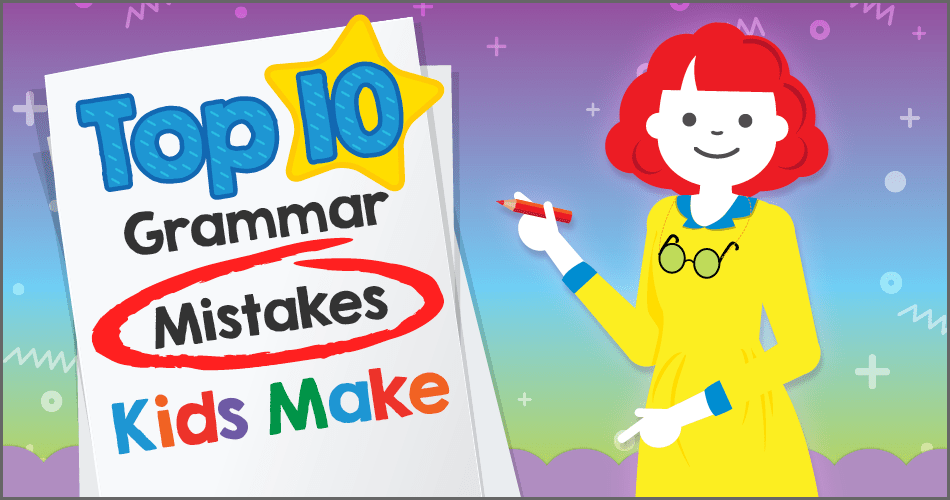 Are you noticing your kids or students making the same simple grammar mistakes over and over? Correcting common grammar mistakes early in kids’ writing is a vital part of building a strong writing foundation and improving writing fluency.
Are you noticing your kids or students making the same simple grammar mistakes over and over? Correcting common grammar mistakes early in kids’ writing is a vital part of building a strong writing foundation and improving writing fluency.
Here are the top 10 most common mistakes kids make in grammar and some ideas to improve them:
1) They’re, their, there
These three words are homonyms, meaning they sound the same but are spelled differently and have different meanings and purposes.
- They’re is a contraction of they are. When teaching they’re, have students expand the contraction to check if it makes sense in a sentence.
- Their is a possessive. Have students ask themselves who owns the object of the sentence to see if their is the right word to use. (ex: It’s their car. Whose car is that? Theirs.)
- There is usually used as a noun or adjective. The easiest way to remember this one is to use it in describing placement. (Ex: There is my car. My cup is there).
Frequent and focused practice is the best way to help children learn these rules. Write practice sentences for your students, some using the correct homonym and some incorrect, and have your students identify the incorrect ones and change them to the correct ones.
2) You’re and your
These two words are another example of homonyms but are a bit easier to remember which one is which.
- You’re is a contraction of you are. Similar to “they’re,” practice this homonym by using its expanded form until students are comfortable with its use.
- Your is a possessive. Students can use the process of elimination to determine if your is the correct homonym, or by remembering “Your does not possess an apostrophe or extra letter.”
A fun way to practice these is to make up silly sentences like “You’re blue bike/Your blue bike” and have students pick the correct one. It’s okay to expand the contraction as they’re learning!
3) Then and than
Not quite homonyms, but this word pairing is also tricky for students to understand.
- Then is often used to talk about time. Students can remember then is used for time because there is a “t” and “e” in both words. There is no “e” in “than.”
- Than is used to compare two things. Exaggerate the “a” sound when teaching this so children can better differentiate between the two.
Have children write “than” and “then” on separate flashcards, two sides of a popsicle stick, or other materials. Read sentences aloud, leaving a blank where the correct word should go, and then have students hold up the right word.
You can make this activity easier by drawing a clock next to then, and a balance next to than to show comparison.
4) Lie and lay
This is a common grammatical mistake in all levels of writing!
- Lie is to recline, like when someone needs to lie down. Have students remember this by noting that lie and recline have similar sounds and letters.
- Lay is to place. There is an “a” is lay, just as there is in “place.”
Students can also remember these like this: Lie usually refers to one’s self or another person (lie = I). Lay is usually an action taken on another object, like to lay down a pencil (lay = a = another).
5) Who and whom
This is another pairing of words that kids find hard to understand, but there is a simple replacement trick to determine which is which.
- Who is often the subject of a verb. If it can be replaced with he, she, or they in a sentence (Who wants ice cream/She wants ice cream), use who.
- Whom is usually the object of a verb. If it can be replaced with him, her, them, or an object (The letter was addressed to whom/the letter was addressed to him), use whom.
Whom is largely ignored in casual speech or writing, meaning kids often don’t get the hang of it until later in their writing careers. If they can nail it down now, they will stand out in their academic efforts.
6) Two, to, and too
This group is another set of homonyms that trips kids up, but each has a very distinct purpose.
- Two is the written form of the number (2.) Have students substitute 2 in the sentence to see if it makes sense, and if it does, use two. If they need help remembering which one is 2, note that “w” is pronounced “double-u.” Hopefully the double will remind them of the number.
- To is a preposition, and usually indicates direction (I went to the store). Students most commonly mix up to and too.
- Too usually means also or additionally. Students can substitute “also” to test if it makes sense (You want to come to the store, also/too?). Note that there is an additional “o” at the end of too, emphasizing that this is the word that means in addition.
Another test to differentiate between “to” and “too” is to remove it from the sentence. If you remove “to” from a sentence, it likely won’t make sense, but if you remove “too” from the sentence, it won’t affect it.
- I want to go to the store to buy ice cream, too.
If you remove to, you get: I want go the store buy ice cream, too.
If you remove too, you get: I want to go to the store to buy ice cream.
7) Affect and Effect
There is a simple spelling trick students can use to remember which word means what in this case.
- Affect is the verb, meaning it is the action. Affect = action, both words start with an “a.” An example is: The rain affected our plans.
- Effect is the noun, and is usually used to show the end result. Effect = end result, both words/phrases start with an “e.” An example is: The rain had an effect on our plans.
Remembering affect/action and effect/end result will help students know which one to use in a sentence.
8) I and me
Knowing which version to use in a sentence can be decided by temporarily dropping other words in the sentence. For example: You and I want ice cream/You and me want ice cream. If you drop the “you and,” you get:
- I: I want ice cream. That sounds right!
- Me: Me want ice cream. That doesn’t sound correct.
Have students use that trick on any sentences where they aren’t sure if it’s I or me, and they’ll be able to figure out which one is correct.
9) It’s and its
This is another simple mistake that can be solved really easily.
- It’s is the contraction of it is. Expand the contraction in the sentence to see if it makes sense.
- Its shows possession. Its does not possess an apostrophe.
10) Principal and principle
This word duo can be differentiated with the pal trick.
- Principal is the head of a school or organization, and is a person. They can be your pal!
- Principle is an idea, truth, or theory. It is an abstract thing, and can’t be your pal.

Free Grammar Tips bookmark: Download and print these grammar tips for your students for a quick reference. Be sure to select “Scale to Print” option on your printer settings for best results. Download
Let us know how you remember these fundamental grammar rules!
For more grammar and language practice, check out these Evan-Moor essentials:
 Skill Sharpeners Grammar and Punctuation is a full-color activity book that makes practicing grammar and punctuation fun! The game-like activities and stickers create positive learning experiences and give children important practice opportunities!
Skill Sharpeners Grammar and Punctuation is a full-color activity book that makes practicing grammar and punctuation fun! The game-like activities and stickers create positive learning experiences and give children important practice opportunities!
 Daily Language Review is available for grades 1–8 with short, daily lessons and activities. The lessons are easy to complete in 15 minutes or less and get children practicing grammar and language.
Daily Language Review is available for grades 1–8 with short, daily lessons and activities. The lessons are easy to complete in 15 minutes or less and get children practicing grammar and language.

About The Author
Christine Wooler has experience working with children as a youth soccer coach and summer camp counselor. She is currently studying English Literature and journalism in college. She enjoys exploring educational topics that help students have fun while learning.
Top 10 Grammar Mistakes Kids Make